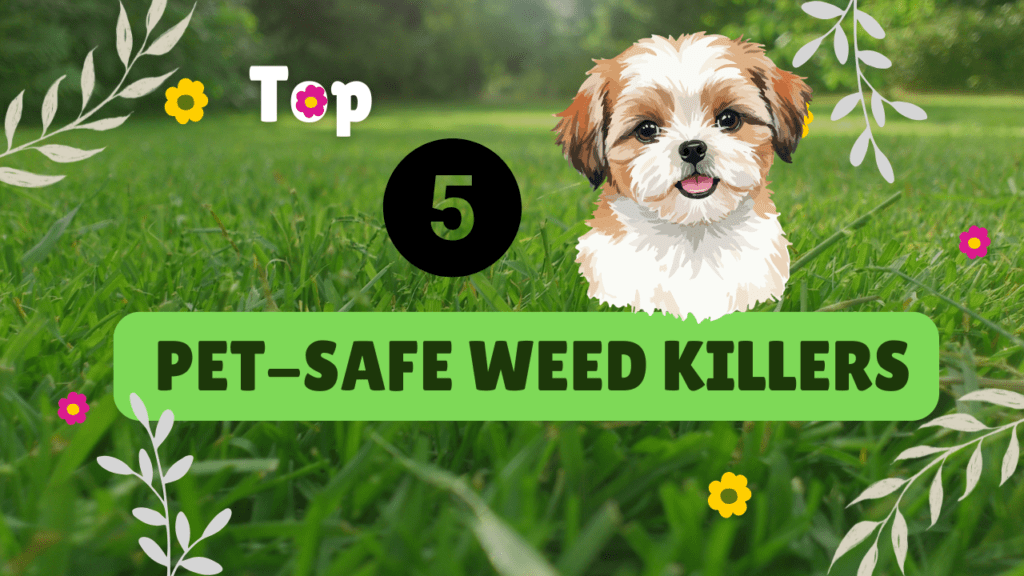
If you’re a pet-loving gardener, you know this scenario all too well: You’re out in the yard, sunshine streaming, a furry companion at your heels, the flowerbeds looking good… and then you spot it—those stubborn weeds creeping up again. You reach for a weed killer… and then pause. Because you realise: are our pets going to be safe after this?
For households with dogs, cats, rabbits, or any four-legged friends, the usual weed-killers (with glyphosate, 2,4-D, synthetic surfactants) can feel like walking a tightrope. You want a clean, weed-free yard and you want your pet to roam freely without worry. The good news: in 2025 there’s a solid lineup of “pet-safe” weed-killer formulas that deliver real weed control and dramatically better safety for your four-legged pals.
In this guide we’ll walk you through why pet-safe matters, what definitions to look for, and then a deep dive into the top 5 pet-safe weed-killers you can get now. I’ll also share homemade alternatives (because sometimes you want DIY control) and best practices. Let’s dig in.
Why Choose Pet-Safe Weed Killers ?
I’ll level with you: I once sprayed a conventional broad-spectrum herbicide around our patio thinking “What could go wrong?” My Labrador shortly after started rolling near a treated strip, licking some damp clover.
Next day: paw-pad redness, slight vomiting. After a vet visit we found out the product contained 2,4-D and other chemicals that lingered in the soil and leaf surface longer than I assumed. That scare taught me the lesson: weed control doesn’t end with “weed dead” — it ends with “pet safe”.
Here’s why pet-safety matters:
Many traditional herbicides contain persistent chemicals like glyphosate, 2,4-D, paraquat, diquat — which can linger on leaves, in soil, get transferred via a dog’s paws or fur.
Pets (especially dogs) often sniff, roll, lick the ground. They may ingest (or absorb through skin/paws) residues that a human might ignore.
Some symptoms of chemical exposure: drooling, vomiting, skin irritation, lethargy. Over time, repeated low-level exposure may increase health risks.
“Pet-safe” doesn’t mean “no risk” — it means the formulation reduces the risk significantly when used properly (including letting the area dry, following label, etc).
So if you love your yard and you love your pets — choosing the right weed-killer is worth it. Not just for aesthetics. For peace of mind.
What Makes a Weed Killer Pet-Safe?
Good question! Here are the key features you want to check — and when I say “check”, I mean read the label, because some products market “pet-friendly” but still have caution flags.
Key Criteria
- Natural or low-toxicity active ingredients: Think vinegar (acetic acid), salt (sodium chloride), plant-based oils/soaps. These work by dehydrating or disrupting weed leaf tissues rather than systemic toxins.
- No glyphosate / 2,4-D / persistent systemic herbicides: These synthetic actives often carry greater risk to pets and take longer to degrade.
- Non-persistent / quick drying / minimal residue: The faster the formula dries off and loses toxicity, the sooner your pet can safely roam. Some pet-friendly labels will say “safe for children and pets once dry”. For example, one brand says: “People and pets may enter treated areas after spray has dried”.
- Biodegradable / safe for environment / gentle on beneficials: If it’s safe for bees, birds, fish, and you have pets – that’s an extra win. Many pet-safe formulations emphasise groundwater safe, fish safe, etc.
- Non-selective vs selective: Many pet-safe weed killers are non-selective (they kill any plant they touch) which means you must apply with care around lawns or plants you want to keep. That’s okay — just know.
Usage Tips
- Let treated area completely dry before letting pets back. Some labels say a few hours, others say up to 24 hrs. Safer to err on the longer side.
- Spot-treat when possible rather than blanket spray. That reduces exposure risk.
- Store product out of paws — even a “pet-safe” herbicide should be kept away from curious animals.
- Even natural ingredients can irritate skin or upset stomachs if ingested wet. So treat them with respect.
Top 5 Pet-Safe Weed Killers of 2025
Here are five highly rated products you can buy (online or locally) in 2025 that meet the pet-safe criteria fairly well.
1) ECO Garden PRO – Organic Vinegar Weed Killer
Ingredients (what’s inside)
A simple, natural trio: concentrated vinegar (acetic acid), salt, and water. The brand markets it as kid- and pet-safe and made from GRAS ingredients.
Performance (what it does)
This is a contact herbicide—it dehydrates weeds fast. Expect visible results within about 24 hours on common broadleaf weeds, young grasses, and moss when you spray in warm, sunny weather.
Safety (for pets & people)
Once the spray dries completely, the area is considered safe for pets and kids. The formula is biodegradable and phosphate-free, designed to avoid lingering residues. (Still, keep pets off the area until it’s dry.)
Coverage & where to use it
One ready-to-use gallon covers up to ~1,000 sq ft, which is plenty for patios, walkway cracks, mulch borders, and along fence lines.
How to apply (quick playbook)
- Pick a dry, sunny window—no rain in the forecast.
- Spray to wet the leaf surface, not to the point of runoff.
- Keep pets off the area until it’s dry. Re-check the spot after a day; re-treat tough perennials as needed.
Pros you’ll notice
- Fast visual knockdown (a day or less).
- Straightforward, ready-to-use formula.
- Minimal environmental baggage for hardscape spots.
Heads-up
- It’s non-selective: it will burn any plant it touches, including turfgrass or ornamentals—use a careful, directed spray.
- You may detect a temporary vinegar scent after spraying (normal for acetic-acid products).
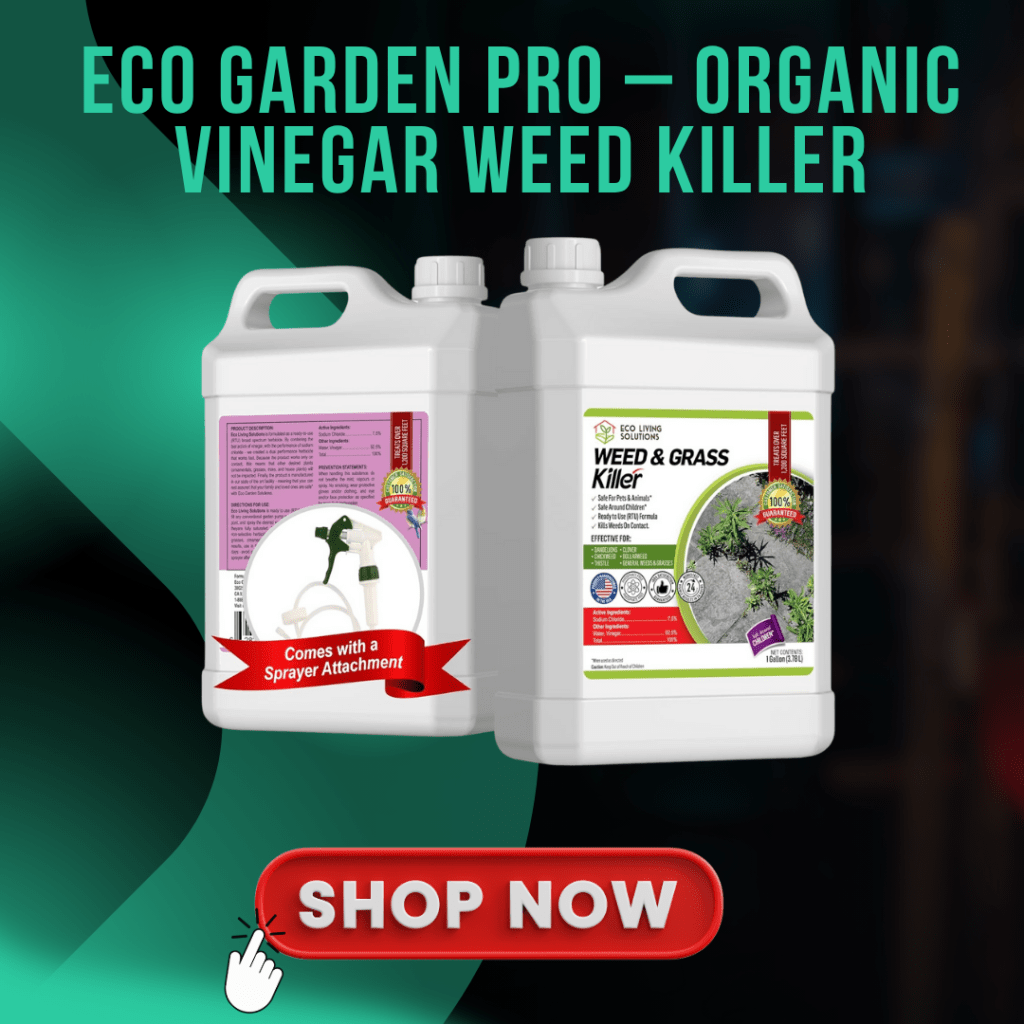
2) Natural Elements Weed Killer
Ingredients (what’s inside)
A familiar natural mix: saltwater + commercial-strength vinegar, plus a small amount of soap to help it stick to leaves.
Performance (what it does)
This one emphasizes speed: the brand states you can see results within hours, with most weeds collapsing inside 24 hours.
Safety (for pets & people)
It’s non-toxic and marketed as safe for pets after it dries. As with any contact herbicide, keep paws off until the surface is dry to the touch.
Best places to use
Great for flower-bed edges, driveways, patios, rock beds, and around trees where you can target individual weeds without touching desirable plants.
How to apply (quick playbook)
- Spray leaves thoroughly on a dry, sunny day.
- Avoid overspray on turf or ornamentals—this is non-selective.
- Keep pets and kids off the area until dry.
Pros you’ll notice
Simple ingredient list you can understand.
Fast action on lots of common weeds.
Heads-up
A vinegar scent can linger briefly.
Deep-rooted perennials may need repeat treatments.
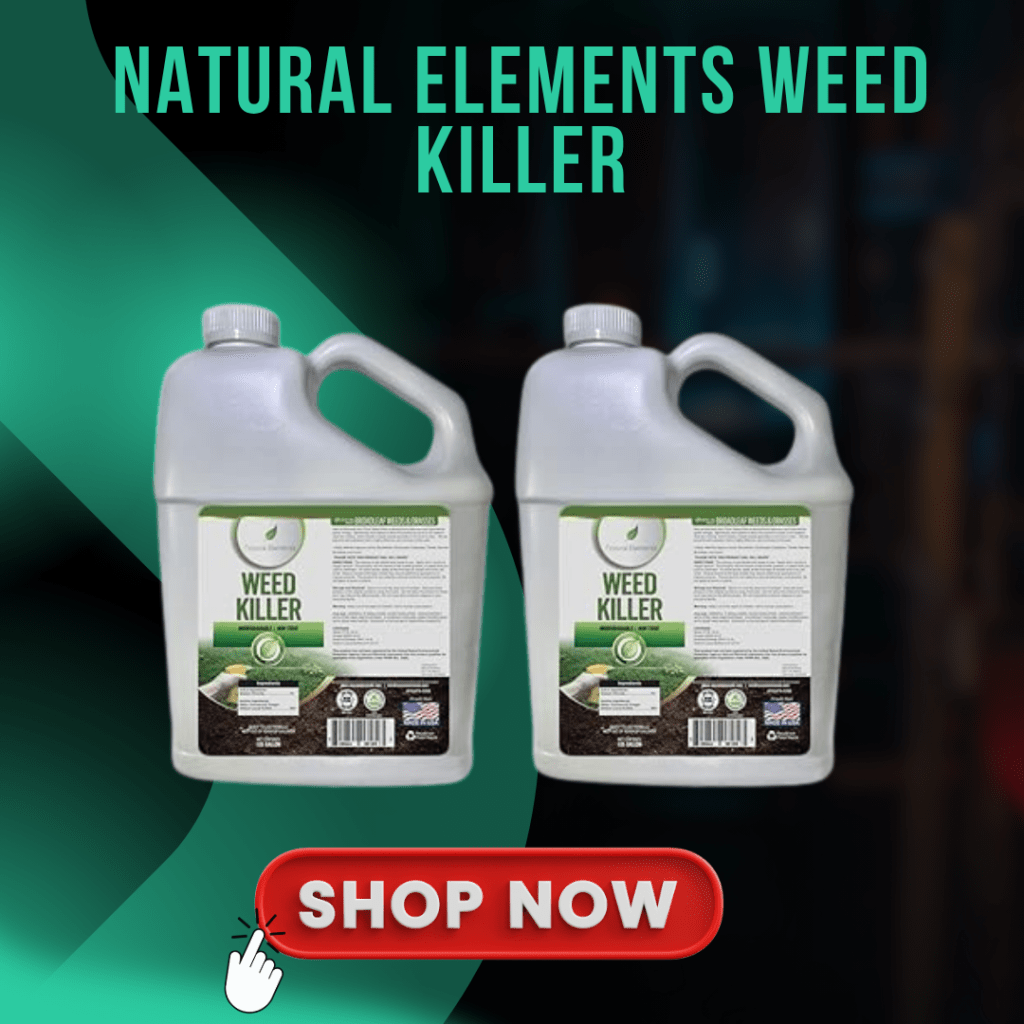
3) Natural Armor Weed & Grass Killer
Ingredients (what’s inside)
A multi-ingredient, plant-forward formula: vinegar, salt (sodium chloride), citric acid, clove oil, sodium lauryl sulfate (soap), lemon juice, glycerin, and water. The brand highlights no glyphosate. The product’s Safety Data Sheet lists these components and typical percentages.
Performance (what it does)
Designed to hit a wide spectrum—250+ types of weeds and grasses—and to brown them quickly on contact. Expect rapid visual results in warm, sunny conditions.
Safety (for pets & around edibles)
Intended for use near pets and around landscape areas; allow surfaces to dry before re-entry. Many homeowners also spot-treat near edible beds (avoid direct contact with edible plant parts and follow label).
Best places to use
Excellent for borders, patios, fence lines, driveway cracks, and other hardscape edges where overspray won’t hit prized plants.
How to apply (quick playbook)
- Spray foliage to full wetness on a dry day.
- Shield desirable plants—this product is non-selective.
- Let the area dry completely before pets return.
Pros you’ll notice
- Broad coverage of weed types (that 250+ claim is the calling card).
- Pleasantly plant-based aroma relative to harsher chemicals.
- Natural Armor
Heads-up
Wear gloves; strong plant acids and oils can irritate skin.
Expect occasional re-treatments for well-established perennials.
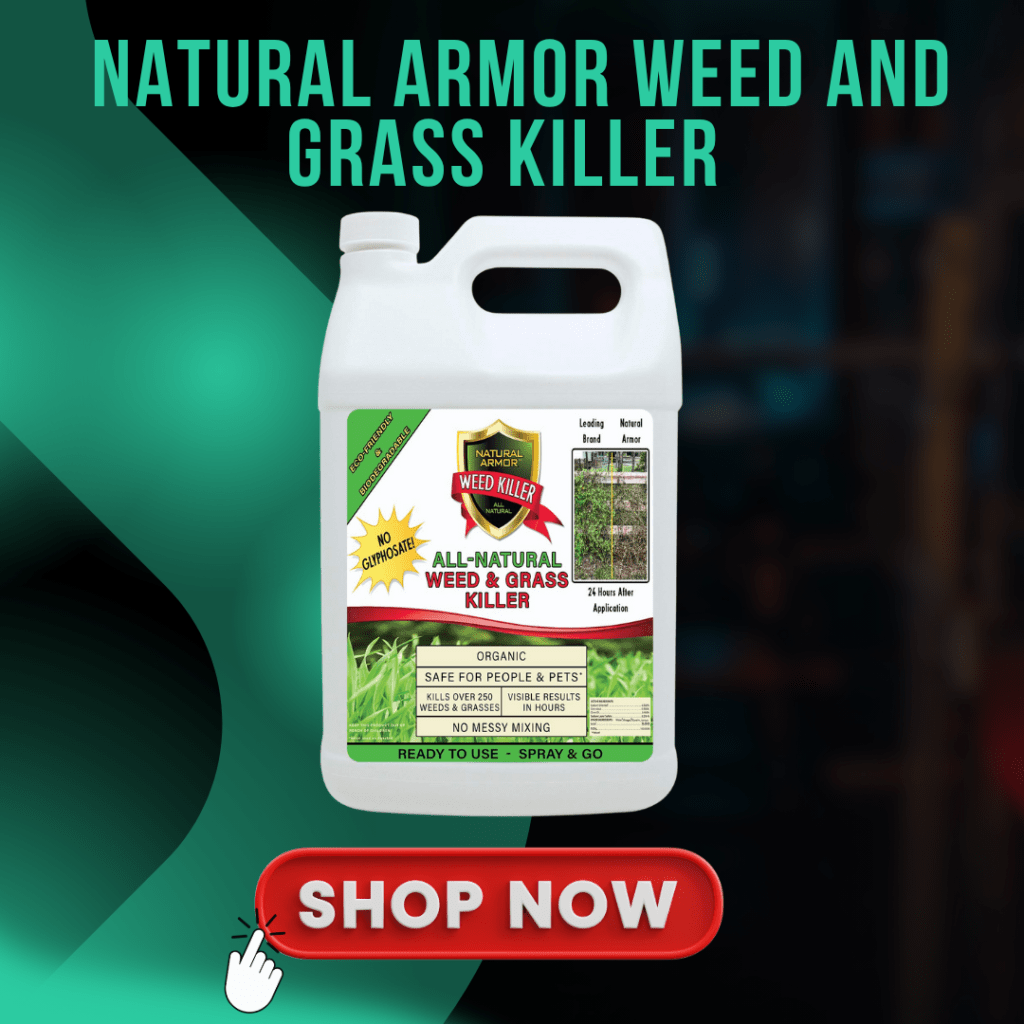
4) Ortho GroundClear Weed & Grass Killer (Glyphosate-Free)
Ingredients (what’s inside)
This glyphosate-free version uses ammonium nonanoate (a fatty-acid herbicide) as the active ingredient.
Performance (what it does)
Engineered for speed: Ortho indicates visible results in as little as 15 minutes, and the product is rainproof once it has dried. This makes it ideal for quick spot-control on hard surfaces.
Safety (for pets & people)
Ortho’s guidance is clear: do not allow pets or children in the area until sprays have dried. After that, normal use resumes. (It’s not for edible plants.)
Best places to use
Perfect for walkways, driveways, gravel, under trees, fence lines, and other non-lawn areas where you want fast knockdown and precise spot treatments.
How to apply (quick playbook)
- Use the Comfort Wand or a directed nozzle to keep spray on target.
- Let the application dry fully before letting pets out.
- Check back in a day or two; repeat if needed on tough weeds.
Pros you’ll notice
- Lightning-fast visual results.
- Easy, accurate spot application; less drift.
Heads-up
- Follow drying times carefully for pet safety.
- Not intended for large-area lawn use or edible gardens.
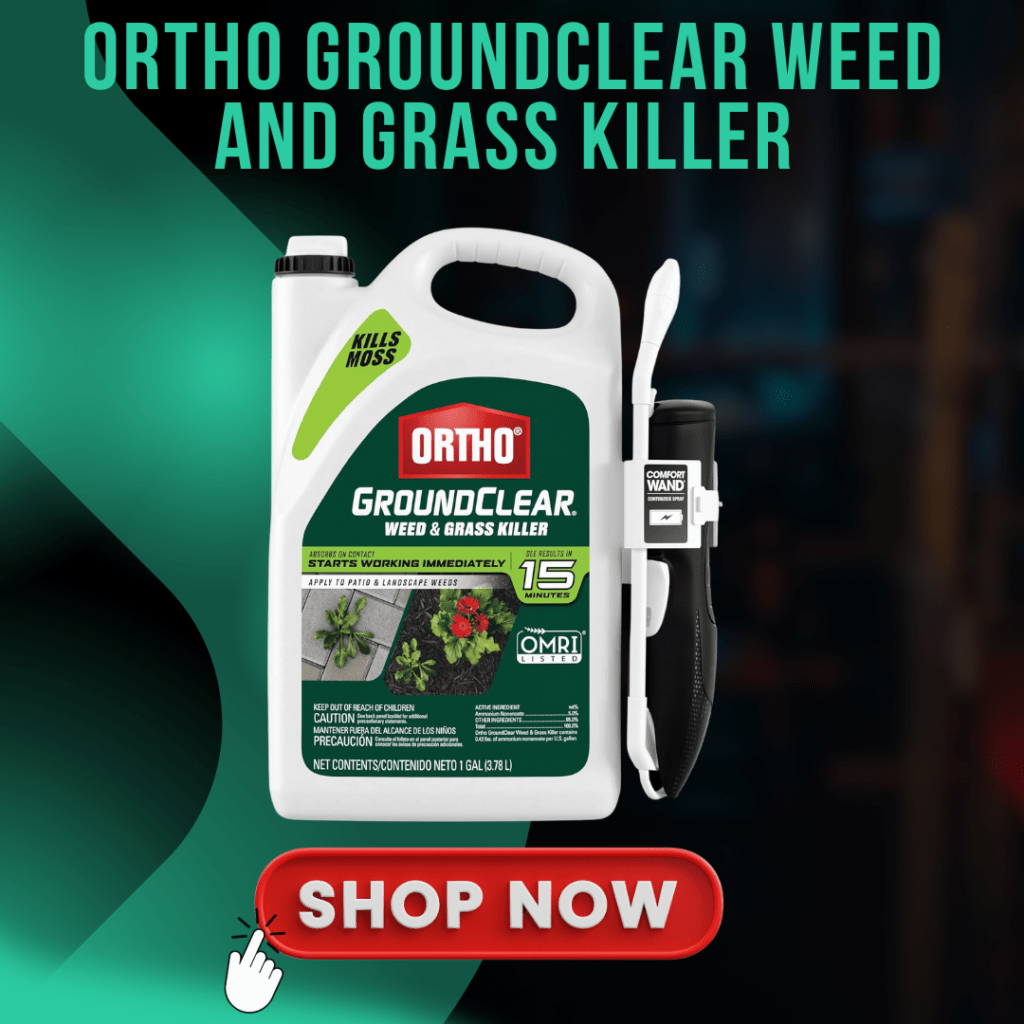
5) Pet’s Pal Natural Weed Killer
Ingredients (what’s inside)
Marketed as all-natural and glyphosate-free; positioned as a pet- and eco-conscious alternative. (Always check your specific bottle’s label for the current active-ingredient list.)
Performance (what it does)
Promoted as quick-acting with effectiveness across a broad range of common weeds (dandelion, clover, thistle, chickweed, crabgrass, and more). As with other contact herbicides, expect the best results in warm, sunny weather and plan on repeat spot treatments for deep perennials.
Safety (for pets, bees, environment)
Listed as glyphosate-free and marketed for pet safety and environmental friendliness. The usual rule still applies: keep pets off until dry, and avoid runoff into garden beds or pollinator-heavy areas.
Best places to use
Great for gardens, patios, mulched beds, and around play areas, where quick visual control and pet safety (post-drying) are priorities.
How to apply (quick playbook)
- Spot-spray weeds on a dry, sunny day.
- Avoid direct spray on desired plants—non-selective rules still apply.
- Let it dry completely before pets re-enter; reassess in 24 hours.
Pros you’ll notice
A pet-owner-friendly positioning and simple, ready-to-use approach.
Minimal odor compared to harsher synthetics (varies by batch/brand).
Heads-up
As with any product sold on marketplaces, check the seller and reviews for authenticity and up-to-date labels before you buy.
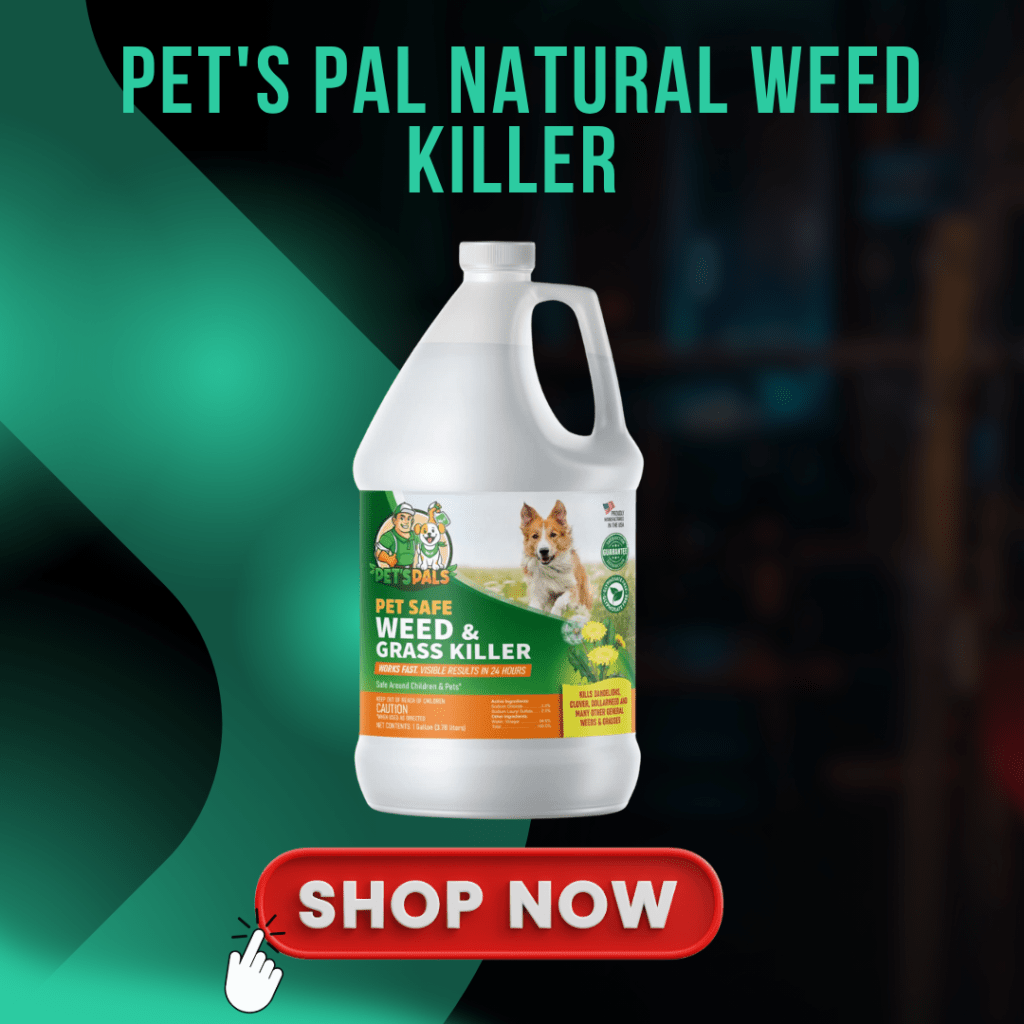
Quick Comparison (what to pick when)
Fastest visible results for hard surfaces: Ortho GroundClear (15-minute claim; pets allowed back after it dries).
Broad natural spectrum + pleasant plant-based formula: Natural Armor (250+ weed types; no glyphosate).
Straightforward, familiar ingredients & quick results: ECO Garden PRO and Natural Elements (vinegar/salt/soap bases with 24-hour targets).
Pet-centric marketplace option: Pet’s Pal (verify current label; glyphosate-free).
Quick review of those tags:
- The first three are strong pet-safe nominees.
- The latter ones include more general herbicides and budget options — but when you use those, you’ll need to check pet-safe claims extra carefully (or restrict pet access longer).
Tips for Using Pet-Safe Weed Killers Effectively
Because even the best product = worthless if mis-used. Here are tips that have served me well.
Read the label, in full — especially the “pets & children” section. Don’t assume “pet-safe” means immediate access. Many say “once dry”.
Spot test: Before a full application, try on a small section and monitor how quickly it dries, whether surrounding plants get affected, whether pets stay away until truly dry.
Choose the right day/time: Sunny, dry day, minimal wind, no rain forecast. Rain will wash away treatment or spread chemical across unwanted plants. E.g., vinegar-based: wind-less day is key.
Allow full drying: Even natural formulas need drying time — lotion on your pet’s paws, licking wet leaves, etc can still cause exposure. As one label states for Ortho: safe once dry.
Keep pets off the area temporarily: It might be 2–24 hours depending on product. Provide alternate play area in that time.
Apply carefully around desirable plants: Since many pet-safe alternatives are non-selective, avoid overspray onto your lawn or flowerbed you want to keep. Mulch beds, cracks, driveways are safer.
Store products safely: Even natural ingredient mixes should be kept locked away from pets and children.
Monitor your pets: After treatment, watch for any signs of strange behaviour (rolling, licking, vomiting, paw-pad redness) and call your vet if concerned.
Complement with good garden practices: Weed early, mulch heavily, repair bare patches of lawn so weeds don’t gain a foothold — fewer weeds = fewer treatments needed.
Homemade Pet-Safe Weed Killer Recipes: DIY That Works
If you’re more of the hands-on type (or want to save on cost), homemade solutions can be surprisingly effective — especially for spot treatment. Just remember: “natural” doesn’t mean “zero risk” — you still must apply properly and keep pets away until dry.
1. Vinegar & Salt Solution
Why it works: White vinegar has acetic acid which dehydrates plant cells; salt increases dehydration of roots; dish soap improves sticking.
Ingredients:
- 1 gallon white vinegar (5% acidity)
- 1 cup table salt (or rock salt)
- 1 tbsp unscented liquid dish soap
Instructions:
- Mix vinegar + salt until salt dissolves.
- Add dish soap and mix gently.
- Transfer into a spray bottle.
- On a dry sunny day, spray directly onto unwanted weeds (avoid desirable plants!)
Safety notes:
- Once the mixture is dry, area is safer for pets.
- Salt can accumulate in soil and damage future plant growth if used broadscale — best for spot treatment (cracks, driveways) not full lawn.
2. Boiling Water
Why it works: Hot water causes cell death where applied — completely chemical-free.
Instructions: Boil a kettle of water, carefully pour directly onto weeds (avoiding plants you want to keep).
Safety notes: No toxins, so pets can return once area cools. But risk of burns to you or pets if residual hot water remains — keep pets away until cooled.
3. Lemon Juice Spray
Why it works: Citric acid in the lemon juice breaks down plant tissue surfaces.
Ingredients:
1–2 cups lemon juice (fresh or unsweetened bottled)
Optionally dilute 1:1 with water for easier spray
Instructions: Pour into spray bottle; spray weeds during warm sunny part of day; watch for wilting in days.
Safety notes: Harmless for pets once dried; avoid excessive use as it may overly acidify soil.
4. Corn Gluten Meal (Pre-Emergent Method)
Why it works: Corn gluten meal inhibits root formation of sprouting seeds — so it prevents weeds from growing rather than killing established ones.
Instructions: Spread across your lawn/garden beds in early spring before weed seeds germinate, water lightly, let dry. Safe for pets immediately after watering.
Safety notes: Doesn’t kill existing weeds, but great for prevention. Pet safe because inert.
5. Rubbing Alcohol Spray
Why it works: Isopropyl alcohol draws moisture out of plant leaves quickly.
Ingredients:
- 2 cups rubbing alcohol
- 1 quart water
- 1 tbsp dish soap
Instructions: Mix in spray bottle, apply to weeds directly. Wilt within days.
Safety notes: Safe for pets once dry. Avoid desirable plants and windy application.
Application Tips for DIY
Best results: apply on early afternoon on a dry sunny day. Sunlight boosts desiccation.
Always shield desirable plants.
Pets: keep away until fully dry and area cooled.
Use spray bottles for precision. Wear gloves with vinegar, alcohol, lemon — they can irritate skin.
For larger lawns or severe infestations, a commercial pet-safe product may be more effective (and easier) than DIY.
For More Gardening related Articles
Also Read:
Windowsill Herb Garden: 7 simple Step-by-Step Guide
How to Start a Lasagna Garden: The Lazy Gardener’s Guide
When to Use Homemade vs. Commercial Pet-Safe Products
Homemade: Best for small gardens, spot-treatments (driveway cracks, between pavers), when you want full ingredient transparency, when budget is tight.
Commercial pet-safe: Better when you have large areas, persistent perennial weeds, want convenience, want proven brand-tested performance.
Hybrid approach: Use DIY for regular maintenance and small patches; use commercial product for more challenging zones.
Final Thoughts
Your garden, your pets, and your peace of mind can all coexist — beautifully. We don’t have to compromise one for the other. In 2025, the lineup of pet-safe weed-killers has never been better. The five options above give you a strong starting point — from fully natural vinegar salt blends to fast-action branded treatments.
But the real secret is this: the care with which you apply. Even the safest product can become risky if your pet licks wet spray, if you miss label instructions, if you don’t block access until dry. So treat it like you would one of your pets: with attention, care, and respect.
Imagine your dog bounding across a clean lawn, tail wagging, no strange patches, no paw-pad irritation — and you standing back, cup of tea in hand, knowing you did it responsibly. That’s the sweet spot.
So next time you spot those weeds, you’re prepared. Pick your product (or DIY recipe), pick your time, follow the safety steps, and let your pets roam happily again.
Frequently Asked Questions (FAQ)
Q: What does “pet-safe” mean for weed killers?
A: It means the product is formulated with ingredients and application instructions designed to minimise harm to pets (dogs, cats, small animals) — typically natural or low-toxicity actives, no persistent synthetic herbicides, and adequate drying-time instructions.
Q: How fast can pets use a treated area?
A: It depends on the product. Some say “once spray is completely dry” (which may be 15–30 minutes in full sun) while others recommend 4–24 hours. Always read the label. For safety, assume longer rather than shorter.
Q: Are pet-safe weed killers safe for children too?
A: Yes — generally they are safer for children, because they don’t contain harsh synthetic herbicides. But you should still follow the drying-time and application precautions. “Pet-safe” does not mean “infinitely safe with no rules”.
Q: Do pet-safe weed killers harm bees or wildlife?
A: Most are formulated to minimise impact on pollinators and wildlife — e.g., many list “safe for bees, fish, groundwater”. But regardless, avoid spraying flowers that bees are using, avoid runoff into water, and follow the product’s instructions.
Q: Can homemade weed killers damage soil?
A: Possibly. For example, vinegar + salt solutions can accumulate salt and alter soil chemistry over time (especially if broadly applied). Best reserved for spot treatments or hardscape areas.
Q: Will commercial pet-safe weed killers prevent weed regrowth?
A: Many kill existing weeds on contact, but since they are often non-selective and don’t always have residual soil activity, you may still need repeat applications. If you want seed-germination prevention, look into pre-emergent options (like corn gluten meal).
Q: Can I use pet-safe weed killers near vegetables or edible plants?
A: With care. Many are safe for surrounding areas, but you should avoid spraying edible plant parts directly. Rinse any vegetables harvested soon after application. Always follow label instructions.
Q: Are pet-safe weed killers selective (i.e., only kill weeds, not grass)?
A: Usually no — many are non-selective, meaning they kill any plant they hit. So you must target weeds carefully to avoid killing turf or plants you want to keep.
Q: What should I do if my pet licks or eats a treated weed?
A: Monitor your pet closely. Most exposures are minor when product is dry and used correctly. But if you notice vomiting, drooling, skin irritation, or lethargy, contact your vet immediately.
Q: Do I need protective gear when applying pet-safe weed killers?
A: Yes — even natural ingredients (vinegar, oils, salt) can irritate skin, eyes or lungs. Wear gloves, avoid windy spray, wash up after applying. Good practice equals good results.
Disclaimer: As an Amazon Associate, I earn from qualifying purchases. This means that if you click on an Amazon link on this site and make a purchase, I may receive a small commission at no additional cost to you.

